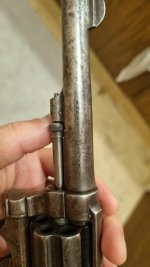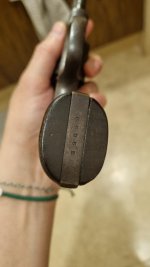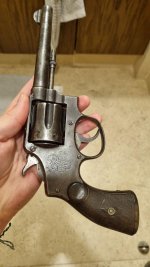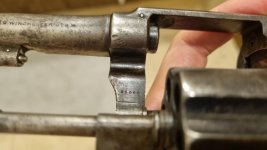- Joined
- Mar 13, 2025
- Messages
- 1
- Reaction score
- 18
Help Identifying a Smith & Wesson Revolver with “Winchester OTO” Marking – Possible M
Hello everyone,
I am looking for help identifying a revolver that has been in my family for generations, and I would love to learn more about its origins, markings, and historical context. The revolver has a “Winchester OTO” marking on the barrel, and I suspect it might be a Smith & Wesson Military & Police model chambered in .32-20 Winchester. However, I am unsure if Winchester ever officially produced revolvers, and I would like to confirm its authenticity.
Key Details & Serial Numbers
Barrel Marking: "Winchester OTO"
Serial Number on Grip: 32520
Serial Number on Yoke (visible when barrel is opened): 28560
Revolver Type: Appears to be a top-break double-action revolver.
Grip Marking: Has a visible Smith & Wesson-style seal.
Condition: Aged but intact, with original wooden grips.
Family Legend – A Pancho Villa Story
This revolver has an interesting family story attached to it. According to my family, during the Mexican Revolution (1910-1920), my great-great-grandfather was working on the train tracks when he had an encounter with a soldier from Pancho Villa’s army. The soldier bullied him, and when Villa saw what was happening, he asked my ancestor:
“Why don’t you defend yourself?”
To which he responded:
“Because he has a gun.”
At that moment, Pancho Villa is said to have handed him this very revolver, saying:
“Here you go, now you have one too.”
The revolver has remained in our family ever since. I would love to confirm if this dates back to the Mexican Revolution era, and if there is any possibility it could have been part of firearms circulating in Villa’s army.
Questions for the Experts Here
Hello everyone,
I am looking for help identifying a revolver that has been in my family for generations, and I would love to learn more about its origins, markings, and historical context. The revolver has a “Winchester OTO” marking on the barrel, and I suspect it might be a Smith & Wesson Military & Police model chambered in .32-20 Winchester. However, I am unsure if Winchester ever officially produced revolvers, and I would like to confirm its authenticity.
Key Details & Serial Numbers
Barrel Marking: "Winchester OTO"
Serial Number on Grip: 32520
Serial Number on Yoke (visible when barrel is opened): 28560
Revolver Type: Appears to be a top-break double-action revolver.
Grip Marking: Has a visible Smith & Wesson-style seal.
Condition: Aged but intact, with original wooden grips.
Family Legend – A Pancho Villa Story
This revolver has an interesting family story attached to it. According to my family, during the Mexican Revolution (1910-1920), my great-great-grandfather was working on the train tracks when he had an encounter with a soldier from Pancho Villa’s army. The soldier bullied him, and when Villa saw what was happening, he asked my ancestor:
“Why don’t you defend yourself?”
To which he responded:
“Because he has a gun.”
At that moment, Pancho Villa is said to have handed him this very revolver, saying:
“Here you go, now you have one too.”
The revolver has remained in our family ever since. I would love to confirm if this dates back to the Mexican Revolution era, and if there is any possibility it could have been part of firearms circulating in Villa’s army.
Questions for the Experts Here
- Is this definitely a Smith & Wesson revolver, or did Winchester ever produce revolvers like this?
- What does "Winchester OTO" mean? Was this a special contract marking, a replacement barrel, or something else?
- Based on the serial numbers (32520 & 28560), can I determine an approximate production year?
- Would this type of revolver have been commonly used in Mexico during the Revolution?
- Any advice on verifying or tracing this revolver’s provenance?
- Photos Attached




